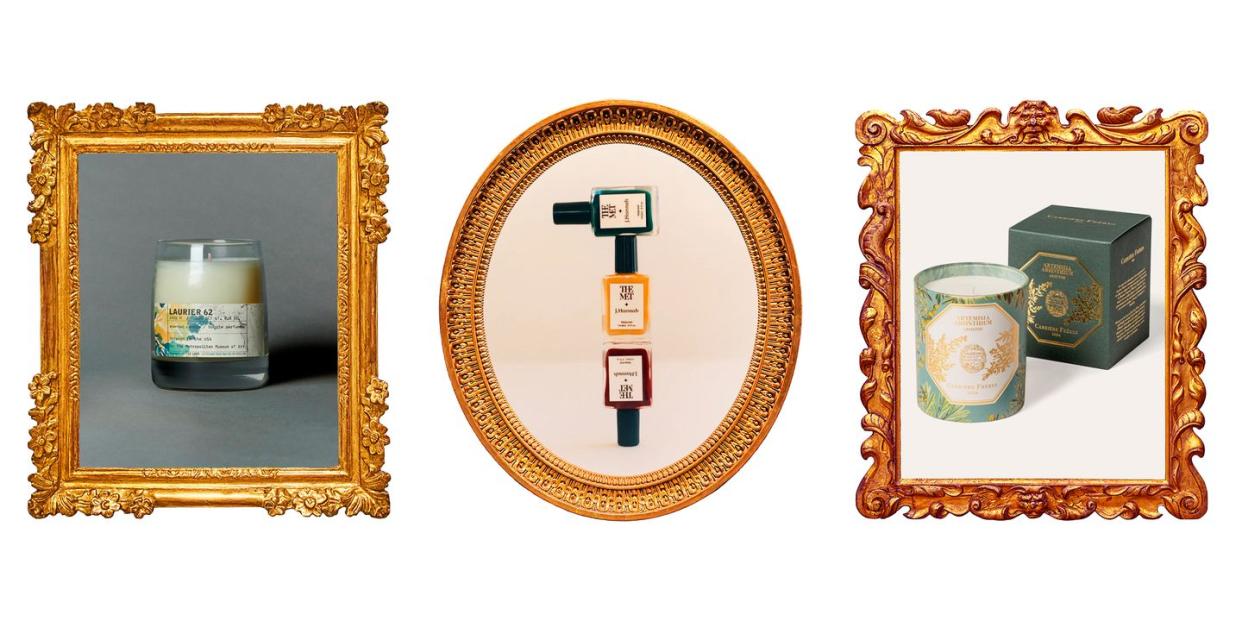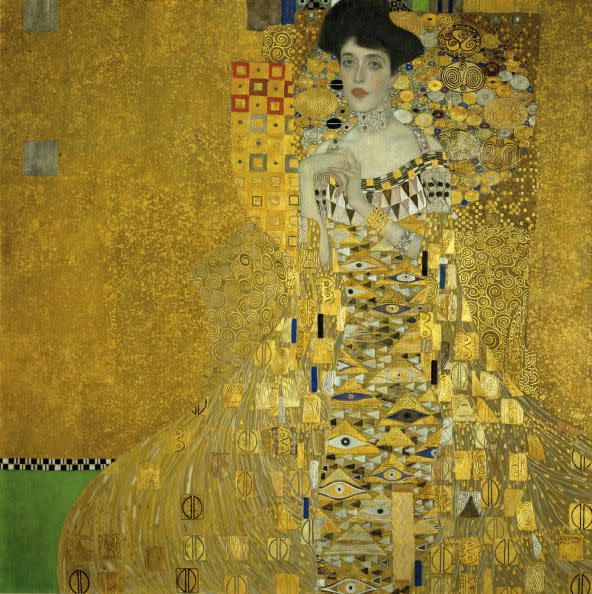Art Museums Are the Hottest New Beauty Collaborations

- Oops!Something went wrong.Please try again later.
"Hearst Magazines and Yahoo may earn commission or revenue on some items through the links below."
Enraptured by that Flemish painting at The Metropolitan Museum of Art’s new “Tudors” exhibition? You can take it home! Well, kind of. You can wear it on your nails. Los Angeles–based jewelry and nail polish brand J. Hannah recently collaborated with the Met to create a polish collection inspired by the rich, ornate jewel tones found in a 1597 portrait by Bruges-born artist Marcus Gheeraerts the Younger. “Who wouldn’t want to take a small piece of that glamour home?” Morgan Pearce, the general manager of marketing, brand partnerships, and licensing at The Metropolitan Museum of Art, asks.
Beauty brands across the globe are reimagining how we interact with museums through one-of-a-kind and limited-edition collaborations across makeup, fragrance, nail polish, and more. But these brands aren’t just taking inspiration; they’re working hand in hand with the museums to create unusual offerings that bring works of art into your home or, in the case of J. Hannah, on the tips of your fingers.
In New York, the Met has an ongoing history of collaborative beauty-focused partnerships, including previous product launches with Estée Lauder, Pat McGrath Labs, Le Labo, and J. Hannah. “The goal of all Met collaborations is to use works of art to tell an inspiring story that connects the customer back to some part of the 5,000 years of human history and creativity housed at the Met,” Pearce says. “The world of beauty allows us so much room to play.” And play they will.
In 2018, the museum collaborated with Pat McGrath, the world’s most celebrated makeup artist, for The Costume Institute’s spring 2018 exhibition, “Heavenly Bodies: Fashion and the Catholic Imagination.” The collection included a decadent eye shadow palette and an iridescent lip gloss both packaged in paintings from the exhibition.
The Candles
Late last year, Harlem Candle Co. released a candle called Seneca in celebration of the Met exhibition, “Before Yesterday We Could Fly: An Afrofuturist Period Room.” Fast-forward to October 2022, New York–based fragrance brand Le Labo launched a special-edition candle celebrating not an exhibit, but just a single painting: the unfinished 1908 piece “Underneath the Cork Oaks” by Henri-Edmond Cross. Le Labo chose a scent already in its arsenal, the complicated and layered Laurier 62. The lesser-known scent was selected for its complex—or “beautiful, chaotic mess,” as the brand notes—ingredients that purposefully counteract the artwork’s quietness. The watercolor and graphite sketched work is right on the label of the candle, and the fragrance has notes of laurel, rosemary, eucalyptus, thyme, cumin, and more—intentionally designed to create a warm, contrasting scent journey.
In Paris, the botanical-forward home fragrance and candle brand Carrière Frères (founded in 1884) partnered with the Muséum National d'Histoire Naturelle (National Museum of Natural History) for a symbiotic collaboration. The philanthropic partnership with the beloved national museum is not only historic, but it’s also a point of patriotism. “The institution is very much revered in France,” Julien Pruvost, the creative director of Carrière Frères and its sister brand, Cire Trudon, says, adding that the museum dates back to 1635 when it was a royal medicinal garden for Louis XIII. The museum has multiple locations, including the most famous one in Paris called the Jardin des Plantes (the Garden of Plants) in the Latin Quarter of the capital. The historic perspective? This is the first brand collaboration ever for the museum, Pruvost notes.
The first collection, which launched this past summer, comprises three unique-scented candles. From the packaging to the fragrance, the candles are a celebration of historic French botany. The museum’s biologists and archivists, Pruvost, and perfumers from Grasse partnered to find plants in the archives that were both unusual and packed with history (in hopes to rekindle the plant’s botanical exploration).
The three original scents are absinthe, acacia, and waterlily. Each is paired with its corresponding archival print (some never seen in public until now) decorating the vessels, with many drawings dating back to the 17th century.
This partnership not only celebrates unseen (and rarely smelt) history—it also gives back to its inspiration. The proceeds from the collaboration go directly to the museum, Pruvost says. Supporting the institution was important to Carrière, given all it accomplishments. “The museum is committed to conservation, research, and education—a theme which is particularly important for the future of the protection of the environment and maintaining younger generations’ interest in nature,” he explains.
For Pruvost, the unique partnership, a dream come true, is also personal. His love for the institution goes back to his childhood spent endlessly roaming the Parisian jardin, and even in primary school, where he attended educational gardening programs with the museum.
The Nails
The textural splendor of Marcus Gheeraerts the Younger’s 1597 portrait of Ellen Maurice inspired Jess Hannah Révész, the founder and designer of J. Hannah, to launch a three-piece polish set. The painting of the wealthy heiress dripping in jewels is part of the Met’s newest exhibition, “The Tudors: Art and Majesty in Renaissance England,” on display until January 2023. “The exhibition spotlights a community of artists who came together to create opulent works of art for their Tudor patrons,” Pearce explains.
The collaboration with the Met, the third with the jewelry and polish brand, was circuitous to ensure creative perfection. “Our polishes are often heavily inspired by works of art, museum artifacts, ancient relics, and artists’ palettes,” Révész says. “In this way, it was a natural match to collaborate with the Met—having the freedom to explore and creatively interpret an element of their vast archives has been the perfect assignment for us.”
In addition to the 1597 portrait, Révész also found herself particularly drawn to the miniature portraits popularized at the time. These pocket-sized portraits hold close ties to jewelry, she explains, noting the mini works of art were often worn as lockets.
The three shades in the set take inspiration from the rich pigments and inventive techniques seen in Tudor-era art, and are just as ingenious today as they were back in the 16th century. They include Velour (a richly layered crimson inspired by opulent tapestries and garments), Bijoux (a deep emerald tone depicting a garden at night), and Relic (a golden tone paying homage to delicate jewelry detailing).
“It’s fascinating to bridge the gap between such grand historical archives and to then go design a product for the present-day guest,” Révész says. “It’s incredibly fun to imagine how a museum visitor might interpret these colors on their own while taking away something tangible from the exhibit.”
The History of Beauty and Art

The worlds of beauty and artistry have long been intertwined. “Historically, the beauty industry and the art world have always been very closely connected since at least the mid-1900s,” Doreen Bloch, executive director of the New York–based Makeup Museum, says. Take beauty magnate Helena Rubinstein’s long friendship with Salvador Dalí and Pablo Picasso, or the Lauder family’s generous contributions to the Met, the Whitney, and Neue Galerie. “Lauder purchased Gustav Klimt’s Adele Bloch-Bauer I for the Neue Galerie, which was, at the time, likely the most expensive art purchase on record,” Bloch adds. (Arguably the most famous of Klimt’s paintings, the piece cost Ronald Lauder a cool $135 million in 2006.)
When it comes to museums and beauty, Shiseido has been supporting artists for more than a century. Since 1919, the Tokyo-based brand has promoted up-and-coming local artists with the Shiseido Gallery. You can even visit the Shiseido Corporate Museum showcasing the brand’s artifacts; “the only beauty brand in the world that does so as far as we are aware,” Bloch says.
Revlon co-sponsored an entire exhibition at the Brooklyn Museum for 2019’s “Frida Kahlo: Appearances Can Be Deceiving.” Not only did Revlon contribute to the financial staging of the exhibit, but it also provided makeup artifacts of Kahlo’s. Within the show, visitors could view the artist’s own red lipstick (her favorite being Revlon’s Everything's Rosy), her go-to blush (Revlon Blusher in Clear Red), and even a wardrobe of Revlon nail colors (from red to frosted pink).
Since 2017, Swiss luxury juggernaut La Prairie has partnered with Art Basel. From New York and Miami to London and Switzerland, the brand has supported a vast array of high-profile projects by emerging artists. One of its most impressive projects to date is the June 2022 show in Basel, where La Prairie gathered five emerging women artists to pay homage to the female figures of the Bauhaus movement. The luxe brand also has an ongoing conservation project close to home with Switzerland’s most popular museum, the Fondation Beyeler, to restore four formative Piet Mondrian pieces.
Where do beauty and museums collabs go from here? “Given the journey of cosmetics in the Western tradition, progressing from renegade and unspeakable in the early 1900s, to must-have, everyday, mass-manufactured product in the mid-1900s, to artistry and high fashion in recent decades, it makes sense that we will see more such partnerships over time—as museums cater to younger patrons seeing experiential moments, and makeup gains its place in the hallowed halls of art history,” Bloch says.
You Might Also Like

